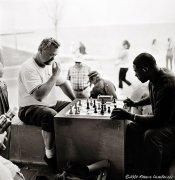Willie Jan
Member
Hi,
With some members of our photoclub we are trying to use the fuji across for making pics in the woods.
Our goal is to have a print that shows the truth...
We do not make pics during the day with a lot of sun. We stay withing the range of 4-5 stops.
What we found out until now is that the across can not register the contrast between dark trees and lighter areas as tri-x does. Rating film as 50 or using pyrocat still does not help. The neg has all the information, but it is not printable.
When we compair the neg with a tri-x neg, they look the same, but the trix is printable and the across not.
Looks like the across can not get more than 3 stops of contrast.
Has anyone got the same problem with this film?
for studio work it is a very good/sharp film. But we do not go beyond 2-3 stops.
With some members of our photoclub we are trying to use the fuji across for making pics in the woods.
Our goal is to have a print that shows the truth...
We do not make pics during the day with a lot of sun. We stay withing the range of 4-5 stops.
What we found out until now is that the across can not register the contrast between dark trees and lighter areas as tri-x does. Rating film as 50 or using pyrocat still does not help. The neg has all the information, but it is not printable.
When we compair the neg with a tri-x neg, they look the same, but the trix is printable and the across not.
Looks like the across can not get more than 3 stops of contrast.
Has anyone got the same problem with this film?
for studio work it is a very good/sharp film. But we do not go beyond 2-3 stops.










 At any rate, I am quite sure that a photograph of a step density card will show that the range of your film is much greater than 3 steps.
At any rate, I am quite sure that a photograph of a step density card will show that the range of your film is much greater than 3 steps.
